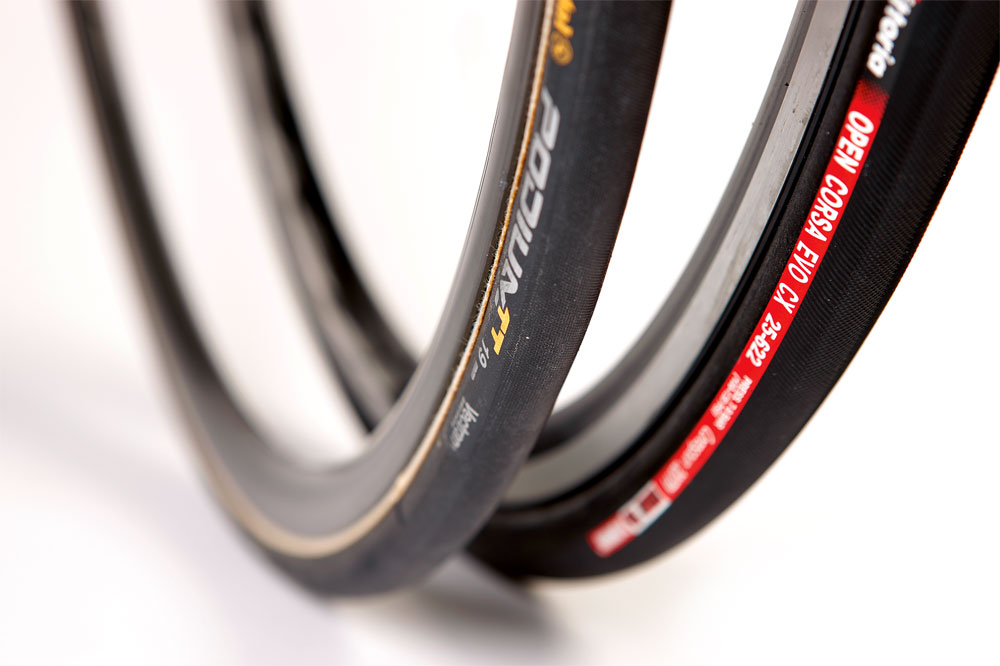Tyre trends set to change?
Richard Hallet explains why thinner is not always better in the world of road rubber

What, exactly, is the point of thin cycle tyres? Not at lot, it turns out. It rather depends what’s meant by ‘thin’.
The tyres on most road bikes look excessively narrow to the few remaining members of the population who are non-cyclists. Even among cycling enthusiasts, there are surely few who can distinguish at a glance between 700x23c and 700x25c rubber, supposing that they care.
Somebody must care; the range of tyre sizes suitable for lightweight road bikes grows by the day, with the current trend being towards fatter rubber.
A useful datum point is arguably, the standard 700x23 format, for many years the default road bike fitment. Narrower tyres are still available; Continental’s Competition tub range starts with a 19mm model. 19mm is a lot smaller than 23mm, even if the 4mm difference in width looks barely worthy of note.
Even 23mm tyres are narrow by the standards of the cycle industry as a whole and rubber of similar dimensions exists purely to satisfy the demands of a small section of the cycling world; the world of performance road riding.
Given that precious few riders spend much time travelling at the speed of professional cycle racers and that tyre manufacturers have begun to make fractionally wider tyres aimed at the same market, it’s not unreasonable to question the fitness of the 23c tyre for its intended purpose. And if it isn’t the right size, what is?
Since the point of thin tyres is to save weight and minimise air drag by reducing frontal area, they’re designed to enhance competitive performance. Weight loss at the tyre (narrower means less material) not only lessens the mass of the cycle, but lowers rotating weight and so greatly improves acceleration.
Air drag becomes an increasingly important source of resistance to motion as riding speed increases and at race speeds of 25mph and more is critical to performance. Only in races run over cobblestones do significantly fatter tyres remain the preferred option; otherwise, thinner is often perceived as faster.
Standard measures
The universal road bike standard 23c clincher tyre meets the desire of enthusiast road riders to emulate racing cyclists. The 23mm clincher has been found comparable in terms of weight, frontal area and rolling resistance with the racer’s 22mm tubular, but with the advantage of easily removable convenience.
Track racers go very fast and ride on tyres inflated to extremely high pressures, so tyres should always be inflated as hard as possible in pursuit of speed.
“On the road, extremely high tyre pressures are self-defeating”
It’s a fallacy, as can easily be proven by carrying out rolling resistance tests on the road. Track tyres can be safely run at very high pressure because a velodrome has a very smooth wooden surface. The tyre doesn’t need to soak up tarmac bumps, which would bounce an over-inflated tyre and absorb energy and slow the cycle. The track tyre needs to be run at high pressure to minimise carcass and tread flex, which also absorbs energy.
On the road, excessively high tyre pressures are self-defeating. Any reduction in carcass flex, or hysteresis energy loss, is more than matched by an increase in bounce, or suspension loss. The optimal pressure is that at which the sum of the two is at a minimum and, for any particular tyre, is dependent on the smoothness of the road surface.
Regulars on Box Hill’s Zig-Zag Road in Surrey will surely be familiar with the sensation it engenders of riding with a soft tyre since it was resurfaced with super-smooth asphalt for the 2012 Olympic road races. A tyre the right pressure for the poor road surfaces nearby is simply too soft for the Zig-Zag’s baby’s-bottom asphalt, but inflating a tyre hard enough to feel right on the hill would make it too hard for surfaces elsewhere.
Narrow mindedness
When it comes to tyre width, a similarly fallacious assumption lies behind the 23c tyre’s popularity; racing cyclists are faster than the rest of us and they ride narrow tyres, so in pursuit of speed we should do the same.
This long-held belief is slowly losing ground — two decades ago, 19mm tyres were widely promoted as the fastest tyre for the road, now pro time triallists are looking with interest at tyres of 23mm and 24mm. This is, in part, because the latest deep-section aero wheel rims works best with tyres of a specific (and usually wider) width, but the lower rolling resistance of fatter tyres can only be welcome.
Their advantages include greater ride comfort and grip and improved resistance to pinch punctures due to the greater air volume of a softer tyre’s larger contact patch. Many road cyclists still prefer extra speed and that’s what fatter tyres offer at riding speeds of 20mph and below. Here, where rolling resistance is more important than wind resistance, is where most sportive and touring cyclists spend their pedalling time. It’s also where a 25c tyre of the same carcass construction, tread compound and thickness will outperform its 23c sibling.
Two millimetres equates to a nine per cent increase in tyre radius and, therefore, an 18 per cent increase in tyre air volume. For comfort, the fatter tyre can be inflated to roughly 5psi less for the same sensation of road surface imperfections, which is a good indicator of suspension loss.
This, in turn, means a larger contact patch; the tyre flattens until its contact patch presses against the road surface with the force of the weight it supports, so a tyre supporting 100lb at 100psi will have a contact patch of one square inch. Inflated to only 95psi, the same tyre has a contact patch five per cent larger, improving grip. Or it can be inflated to 100psi, in which case the contact patch will be the same size, but slightly shorter and wider. This creates less carcass deflection than the long, narrow patch of a thinner tyre, reducing rolling resistance loss.
Back in the day
The advantages of fat road rubber were best appreciated by the French randonneurs of the 1920s and 30s, who enjoyed the famous ‘ballon’ tyres of the time. The famous 650b French touring format is equivalent to the British 26x1½ tyre.
These 650b road tyres are still available, but they need an unusual 584mm rim. Some slick tyres for mtb rims are close to this size, but are usually heavy, due to a range of factors including thicker tread.
The answer is something that fits road-bike rims, but with a width of around 30mm. This is arguably ideal for all-round non-competition riding, provided the carcass construction is lightweight enough to ensure that the tyre isn’t unduly heavy. Continental’s new Gatorskin tyre has a nominal width of 32mm and, in folding bead format, weighs 320g thanks to a fine carcass and the same thin tread found on Gatorskin’s lightweight training tyres.
This may be a bit too heavy for most performance road cyclists, for whom the 250g or so of a 25mm tyre is more attractive.
Besides, most road bikes don’t have the clearance for such a fat tyre. But, given that it prioritises rolling resistance over weight and width, it’s faster the slower you go, which must suit somebody.
This article was first published in the January 16 issue of Cycling Weekly.

Thank you for reading 20 articles this month* Join now for unlimited access
Enjoy your first month for just £1 / $1 / €1
*Read 5 free articles per month without a subscription

Join now for unlimited access
Try first month for just £1 / $1 / €1
Get The Leadout Newsletter
The latest race content, interviews, features, reviews and expert buying guides, direct to your inbox!
Founded in 1891, Cycling Weekly and its team of expert journalists brings cyclists in-depth reviews, extensive coverage of both professional and domestic racing, as well as fitness advice and 'brew a cuppa and put your feet up' features. Cycling Weekly serves its audience across a range of platforms, from good old-fashioned print to online journalism, and video.
-
 'I've worked a lot on my sprint' - Kristen Faulkner plots unpredictability on racing return
'I've worked a lot on my sprint' - Kristen Faulkner plots unpredictability on racing returnOlympic champion looking forward to "exciting challenge" of continuing to outfox bunch
By Tom Davidson
-
 'This is a fresh start' - Belgian rider returns to professional cycling after two year anti-doping ban
'This is a fresh start' - Belgian rider returns to professional cycling after two year anti-doping banShari Bossuyt to ride for AG Insurance-Soudal from June
By Adam Becket